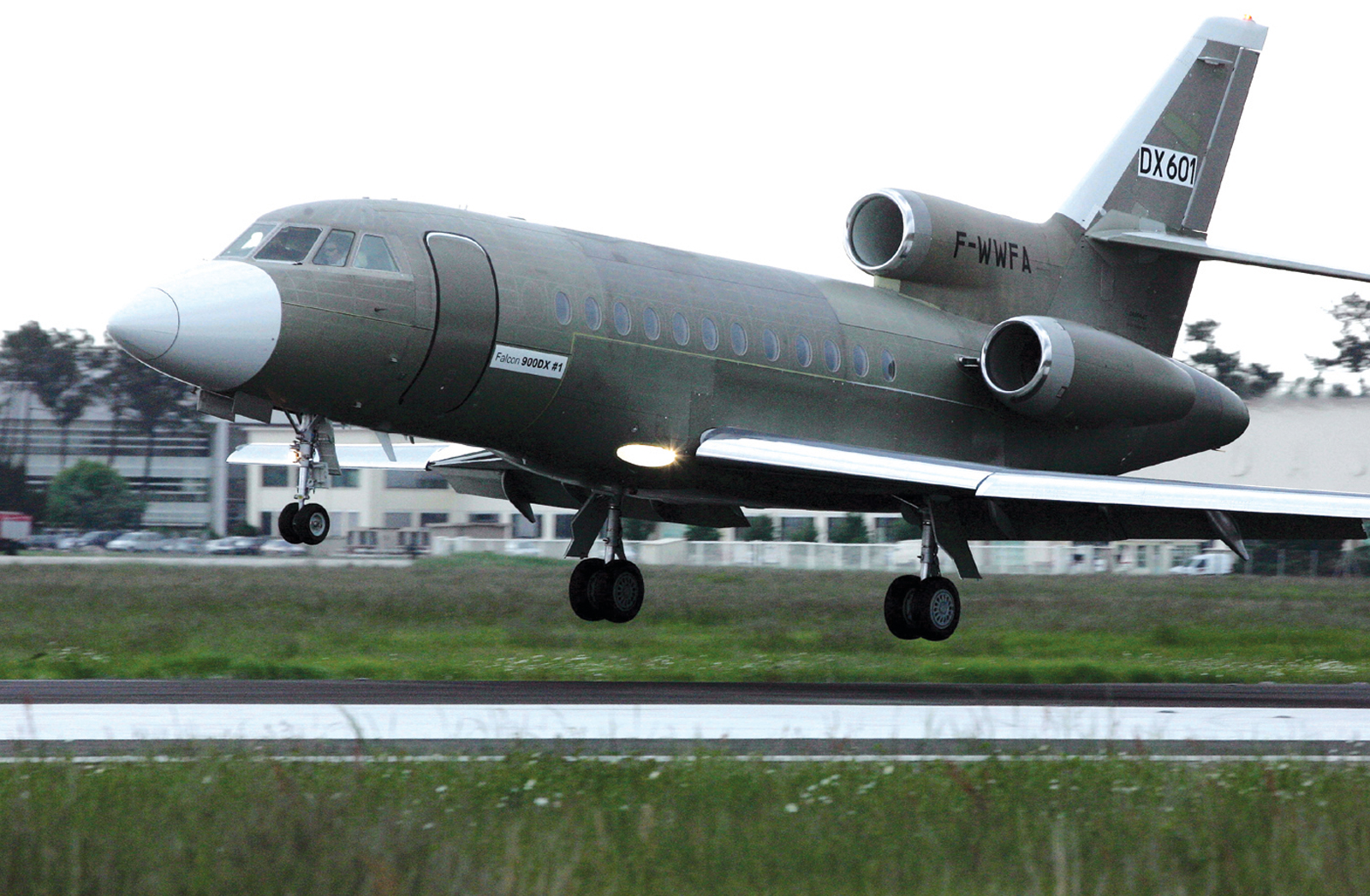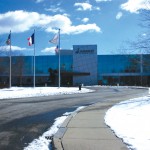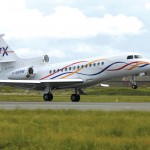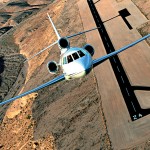By Henry M. Holden,
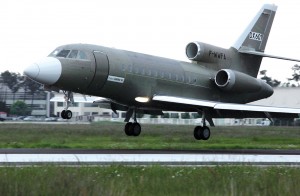
The Falcon 900DX made its first flight on May 5, 2005, in its “green” condition at Bordeaux, France, and reached an altitude of 41,000 feet.
Dassault Aviation CEO and Chairman Charles Edelstenne recently announced record sales of Falcon business jets in 2005, with 123 firm orders. This marks the first time the company sold over 100 Falcons in one year, and this is without the benefit of multiple sales to fractional providers. The Dassault Aviation consolidated 2005 sales were over $5.3 billion with 90 percent coming from 123 Falcon business jet sales.
Dassault Falcon, the American subsidiary of Dassault Aviation, is responsible for selling and supporting Falcon business jets and has a presence in over 70 countries, across five continents. Dassault Aviation has assembly and production plants in France, and the United States, and service facilities on both continents. It employs a total workforce of over 12,000, 350 of whom are at Dassault Aviation’s western hemisphere headquarters and flight operations center in Teterboro, N.J. They also maintain a service center in Wilmington, Del., and a completion center in Little Rock, Ark.
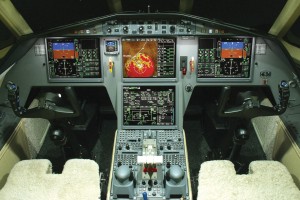
The 900EX flies 4500 nautical miles nonstop, the farthest in its class. With its classic tri-jet engine design, the 900EX can use small airports at high altitudes, even on hot days.
Dassault Aviation produces the renowned Mirage and Rafale fighter jets and entered the civilian market in 1963. Today they have a complete line of Falcon business jets. The family of Falcon jets currently in production includes the tri-jets—the Falcon 50EX, 900DX, 900EX EASy, and the new 7X—as well as the twin-engine Falcon 2000 and 2000EX EASy.
Since the rollout of the Mystére, predecessor to the Falcon 20, in 1963, over 1,650 Falcon jets have been delivered to more than 65 countries worldwide. Until recently, the first Falcon delivered in the United States was still in service with its original operator. Now it ferries executives between company locations.
“The year 2005 represents a high mark in the history of the Falcon program,” said Edelstenne. “And demand is strong worldwide.”
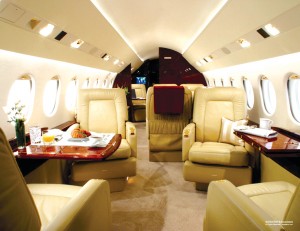
The length of the Falcon 900DX cabin measures 33 feet, 2 inches, from the cockpit divider to the aft pressure bulkhead, devoting 25 feet to passenger seating. It’s a broad 7 feet, 8 inches wide and 6 feet, 2 inches high.
Traditionally, about 60 percent of Falcon jet sales have come from the U.S. market. In 2005, however, that percentage was about 50 percent. Edelstenne doesn’t see this as a sign of a weakening U.S. market, but as a sign of strengthening worldwide demand.
At the end of 2005, Dassault had a total backlog of more than 200 aircraft. The company expects more than 60 aircraft will be delivered in 2006, compared to 51 last year, coming close to the 75 delivered in 2001. A similar delivery rate increase is expected for 2007. On the military side, since the Mirage fighter production line is officially shut down, the company expects to deliver 15 Rafale fighters this year.
Last year saw a number of milestones in several Falcon programs, which improved the end of year sales figures. The Falcon 7X flew for the first time on May 5, 2005. Three airplanes are now involved in a 1,200-hour flight test program. About one-third of this program has been completed, with 450 flight hours and 150 flights performed. Design changes will push the certification out to the first quarter 2007, with the first deliveries now scheduled for second quarter 2007. The payload capacity of the 7X has been increased by 50 percent (over its original 1,900 lbs.), and the flight envelope has been fully opened.

The length of the Falcon 900DX cabin measures 33 feet, 2 inches, from the cockpit divider to the aft pressure bulkhead, devoting 25 feet to passenger seating. It’s a broad 7 feet, 8 inches wide and 6 feet, 2 inches high.
Speeds up to Mach 0.92 have been achieved and the aircraft has reached 51,000 feet. Over 80 copies of the 7X have been sold, making it the most successful Dassault Falcon aircraft at this point in the life of the program. Currently 30 aircraft are in various stages of production with s/n 4, 5, and 6 complete and s/n 7 in final assembly. The next available delivery position is in early 2010. To accommodate the demand, production will increase to three per month during the second half of 2007.
On May 13, 2005, the Falcon 900DX flew for the first time. Announced in May 2004, the airplane achieved both European Aviation Safety Agency and Federal Aviation Administration certification in October 2005, with two delivered by the end of the year. The Falcon 900DX has achieved strong global demand and 15 aircraft are currently in various stages of production.
Citic, the largest state-owned financial services holding company in China, recently placed its first order for the new Falcon.
“This order represents a very big step forward for Dassault,” said John Rosanvallon, president and CEO of Dassault Falcon Jet. “Not only because it’s our first firm order for a new aircraft in China, but also because Citic is a highly respected member of the corporate community. We expect this to influence other public and private Chinese corporations to purchase a business jet. In the longer term, China will start to mature in the next five to 10 years, thanks to their strong economy and more favorable regulations.”

On the Falcon 900EX EASy, three fuel-efficient Honeywell TFE73 1-60 turbofan engines deliver 5000 lbs of thrust each.
Citic will take delivery of their Falcon 900DX, which will be based in Beijing, in late 2007. While waiting for delivery, Citic will operate a pre-owned Falcon 2000.
Following on the strength of the 900DX program, the Falcon 2000DX was announced at the National Business Aviation Association convention in Orlando, Fla., in November 2005. The 2000DX will climb to 41,000 feet in 17 minutes, with a range of 3,250 nm, and will have the same spacious cabin as the Falcon 2000EX. The design phase of the 2000DX has been completed and the first aircraft is in the early stage of production. It will replace the popular Falcon 2000 in late 2007 when deliveries begin.
Since the company’s net cash position is healthy, officials are developing plans for a mid-size “super” Falcon speculatively called Falcon 5X. It will incorporate many of the 7X features, such as the new high trans-sonic wing and fly-by-wire system.
The Dassault Falcon Jet completion center, which opened in 1975 in Little Rock, is the main completion center for all Falcon jets worldwide. Current production model Falcons are manufactured in France, and then flown in the “green” condition to the completion center where optional avionics and a custom interior are installed and the exterior is painted.

The cabin of the F2000EX boasts 6 feet, 2 inches of headroom, a width of 7 feet, 8 inches, and 26 feet, 2 inches of passenger seating space.
In the past 30 years, nearly 900 Falcons have been completed at the Little Rock facility. Increased sales of the Falcon line have virtually doubled the size of that completion center, and a major portion of a three-year expansion project has been completed. The latest expansion involved the construction of seven major buildings, and increased the size of the facility by nearly 200,000 square feet, to a total of 478,500 square feet. Upon completion in late 2006, the physical footprint of the Little Rock facility will be over 685,000 square feet, which is over 10 times the size of the original facility that Dassault purchased 30 years ago.
For more information, visit [http://www.dassault-aviation.com] or [http://www.falconjet.com].
- The Falcon 7X is seen here touching down after its first flight on May 5, 2005. The new Falcon 2000DX affords more companies the opportunity to move up to the wide-cabin comfort and 3,250 range of a larger jet.
- The Dassault Falcon headquarters for the western hemisphere is located in Teterboro, N.J.
- The Falcon 7X rolled out at Dassault Mérignac, France, on Feb. 15, 2005. The Falcon 7X is designed to fly 5,700 nm with eight passengers and has a .90 Mach maximum operating speed. The Falcon 7X achieves its maximum range with a crew of four (three pilots
- The Falcon 50EX flies eight executives 3,075 nautical miles at .80 Mach nonstop. It requires a mere 4,890 feet of runway even at maximum gross takeoff weight.











